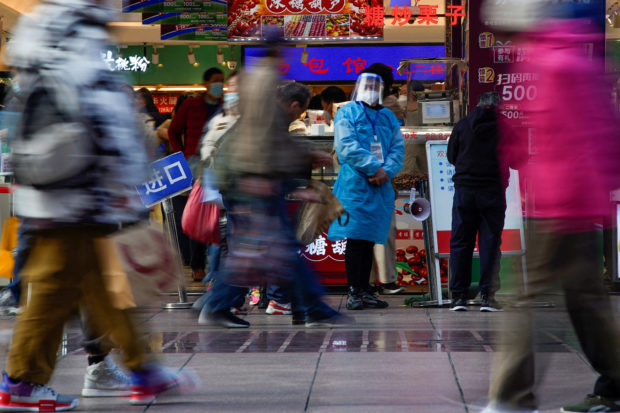
FILE PHOTO: A worker in a protective suit stands at a food shop, as coronavirus disease (COVID-19) outbreaks continue in Shanghai, China, on December 12, 2022. REUTERS/Aly Song
BEIJING — On November 21, Vice Premier Sun Chunlan, in charge of China’s war on COVID-19, said infections had to be brought down to zero as they emerged. Nine days later, she said the Omicron strain of the virus had “weakened” even though new cases in the Chinese capital hit a high.
Last week, in one fell swoop, China cut away most of the tenets governing its stifling zero-COVID policies, effectively ending its war on the pandemic. It has since turned to re-educating people on the harmlessness of Omicron and pushing the idea of self-care, a dramatic U-turn from quarantine camps and crushing lockdowns that sparked recent, rare public protests.
Saoirse Zhou, an undergraduate in Guangzhou, said she had been considering fleeing her campus, having lived in constant fear of being locked down in her dormitory. The overnight about-turn came as a shock.
“The complaints of the masses were peaking, and policies needed to change before the lockdowns could cause any more discontent,” she said.
READ: ‘Please protect yourself’: China wrestles with COVID-19 surge
Since the curbs were dismantled, China’s massive propaganda machine has repeatedly assured people through news reports, public advisories and media briefings that most will have mild or no symptoms if they are infected and can self-isolate at home. “Be the first person responsible for the epidemic”, it has said, which is emerging as China’s new public health slogan.
Some people have happily supported the view. In Shanghai, which endured a two-month long COVID lockdown earlier this year, many residents could be seen out shopping or gathering with friends at restaurants and soaking up the Christmas spirit at crowded fairs.
But in Beijing, where infections have surged in the past week, the local emergency hotline has been overwhelmed by over 30,000 calls per day, prompting officials to remind those with mild or no symptoms to refrain from using the special line meant for emergency medical assistance.
The challenge to re-educating the masses to the new narrative would be any surge in fatalities and obstacles to public healthcare.
So far, China’s official COVID death toll remains unchanged at 5,235 since the domestic epidemic curbs were removed.
“The tone now will be how China is not going to see mass deaths, there will be few severe cases, and how the country managed to deal with a surge of cases without incurring lots of deaths – I think that will be the main narrative in the coming months,” said Yanzhong Huang, a global health specialist at the Council on Foreign Relations (CFR), a U.S. think tank.
‘What a chameleon’
People amazed at the policy flip-flop were allowed to vent on social media, even though the platforms are heavily policed. One prominent epidemiologist was mocked for saying in October Omicron’s fatality rate was up to eight times greater than that of influenza, and then saying this month the pathogenicity of Omicron had “obviously” decreased.
“What a chameleon” and “two-face” were among the comments permitted to float on China’s Twitter-like platform, Weibo.
READ: ‘It’s dead out here’: China’s slow exit from ‘zero-COVID’ policy
The suddenness of the policy shift has not yet been explained to the public, except that Omicron has weakened. Officials have also not explained why they had not started preparing the population earlier, such as ramping up vaccinations among the elderly. Omicron was first detected in China in late 2021.
As the shock of the policy shift fades, how Beijing deals with a growing wave of infections that Chinese experts say will see its first peak within one month remains uncertain.
But the public health message is: do not worry.
State-run news agency Xinhua published a story last week that said a 101-year-old woman in Xinjiang with hypertension successfully recovered from COVID after 10 days of treatment at a local hospital. It cited her daughter as saying the recovery was “miraculously fast.”
But Beijing resident Charlie Zhang, 42, said he was not enthused about the recent dramatic changes in COVID policies, believing it would be hard for the elderly to recover from Omicron.
“And what about the elderly people who already have some underlying diseases?” he said.
RELATED STORY
China’s healthcare system put to the test as COVID-19 curbs fade